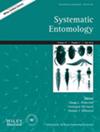古近系森林破碎化和走出非洲的扩散解释了古热带蜣螂部落Epactoidini部落的辐射。11 .(鞘翅目:金龟甲科)
IF 4.7
1区 农林科学
Q1 ENTOMOLOGY
引用次数: 5
摘要
具有大量不相交分布的古热带枝是生物地理重建的理想模型。粪甲虫属Grebennikovius Mlambo、Scholtz & Deschodt、Epactoides Olsouffief和Ochicanthon Vaz‐de‐Mello分别分布在坦桑尼亚、马达加斯加和卢旺达以及东方地区。我们结合形态学和分子数据来重建这些分类群之间的系统发育关系。我们的分析证实了先前关于该群体单一性的假设,这里将其描述为新部落Epactoidini部落。11 . Grebennikovius被发现是Epactoides的姐妹,而Ochicanthon则是它们的姐妹。我们的焦点分支的间断分布在金龟子亚科中是不寻常的。贝叶斯分化时间估计和祖先范围重建表明Epactoidini部落的冠群起源于非洲。11月始新世早期中期,约46 Ma。Epactoides及其姊妹属的分化时间为32.3 Ma,而Ochicanthon属的冠年龄为27 Ma。我们调查的因素,可能已经形成了部落Epactoidini部落目前的分布。11 . Gomphotherium陆桥的形成,以及有利的环境条件,将允许不耐干燥的生物,如Ochicanthon,扩散出非洲。东弧山脉显著的气候稳定性对单型属的保留至关重要。我们提出了两个后续的水上扩散事件:Epactoides最近的共同祖先(MRCA)从非洲迁移到马达加斯加(32.3-29.5 Ma);今天已经灭绝的巨猴Epactoides giganteus Rossini、Vaz - de - Mello和Montreuil的MRCA最近从马达加斯加向r本文章由计算机程序翻译,如有差异,请以英文原文为准。

Paleogene forest fragmentation and out‐of‐Africa dispersal explain radiation of the Paleotropical dung beetle tribe Epactoidini trib. nov. (Coleoptera: Scarabaeinae)
Paleotropical clades with largely disjunct distributions are ideal models for biogeographic reconstructions. The dung beetle genera Grebennikovius Mlambo, Scholtz & Deschodt, Epactoides Olsouffief and Ochicanthon Vaz‐de‐Mello are distributed in Tanzania, Madagascar and Réunion, and the Oriental region, respectively. We combine morphology and molecular dataset to reconstruct the phylogenetic relationships between these taxa. Our analyses corroborate previous hypotheses of monophyly of the group, which is here described as new tribe Epactoidini trib. nov. Grebennikovius is recovered as sister to Epactoides, while Ochicanthon emerges as sister to them both. The disjunct distribution of our focal clade is unusual within the subfamily Scarabaeinae. Bayesian divergence time estimates and ancestral range reconstructions indicate an African origin of the crown group of the tribe Epactoidini trib. nov. in the early mid Eocene, ca. 46 Ma. The divergence between Epactoides and its sister is dated to 32.3 Ma, while the crown age for the genus Ochicanthon is dated to 27 Ma. We investigate the factors that may have shaped the current distribution of the tribe Epactoidini trib. nov. The formation of the Gomphotherium landbridge, along with favourable environmental conditions would have allowed dry‐intolerant organisms, such as Ochicanthon, to disperse out of Africa. Remarkable climatic stability of the Eastern Arc Mountains was critical for the retention of the monotypic genus Grebennikovius. We suggest two subsequent overwater dispersal events: the migration of the most recent common ancestor (MRCA) of Epactoides from Africa to Madagascar (32.3–29.5 Ma); the lately dispersal of the MRCA of the today's extinct Epactoides giganteus Rossini, Vaz‐de‐Mello & Montreuil to Réunion island from Madagascar (3.4 Ma). We suggest that the high potential of dispersal of Epactoidini trib. nov. dung beetles and the strict association to forest habitat might have triggered two major radiations, one in Madagascar and one in the Oriental Region.
求助全文
通过发布文献求助,成功后即可免费获取论文全文。
去求助
来源期刊

Systematic Entomology
生物-进化生物学
CiteScore
10.50
自引率
8.30%
发文量
49
审稿时长
>12 weeks
期刊介绍:
Systematic Entomology publishes original papers on insect systematics, phylogenetics and integrative taxonomy, with a preference for general interest papers of broad biological, evolutionary or zoogeographical relevance.
 求助内容:
求助内容: 应助结果提醒方式:
应助结果提醒方式:


